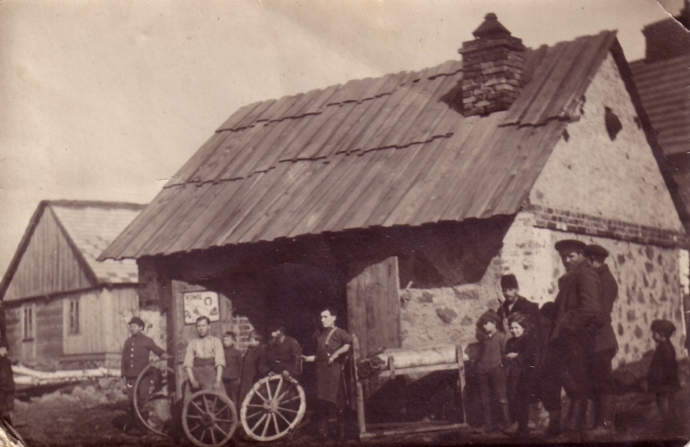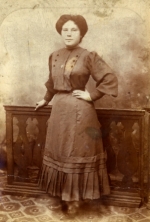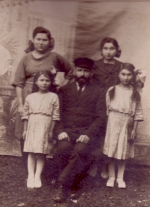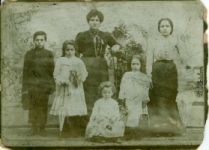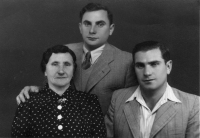|
HISTORY OF THE KOWALSKI FAMILY
The surname Kowalski is derived from the Polish for blacksmith (“kowal”) and anvil (“kowadło”), and the Kowalski family were all traditionally blacksmiths in the town of Radzilow in north-east Poland. Along with the related Piechota and Chemnicki families, the Kowalski family is one of the very few that has been traced back to the mid-18th century in the region.
The earliest Kowalski ancestor currently known is Szymek Kowalski, whose grandson Dawid was born in Radzilow around 1800. In 1826, Dawid married Krejna Chemnicka, whose family came from the hamlet of Karwowo, just outside Radzilow. Dawid and Krejna had a number of children over the next 15 years or so, all bar one of whom survived into adulthood. Ick Szymek, the eldest, had a daughter named Rywka by his first wife, and she married a man named Abram Kaminski. He was known as “Avram el Dranke”, and family legend in the British-based branches attributes this to his fondness for alcohol. However, documentary evidence suggests the Kaminski family lived in a hamlet just outside Radzilow called Dranki-Szlasy, and Abram’s nickname could be a reference to the fact that he and his family lived there. The Kaminski family was substantial and descendants spread to four continents, although many young members of the family lost their lives in the pogrom on 7 July 1941.
Read about the Radzilow pogrom of 7 July 1941, in which the town’s Jewish population was massacred
View the Tyszkowski group memorial page for Holocaust victims
See photos of Shim Kaminski and his family after he emigrated to England
Ick Szymek's eldest known daughter, Fejga, married a man named Froim Kuberski and had at least two children with him in the 1870s. However, when Fejga died tragically young, Froim married her half-sister, Masza, who was from Ick Szymek's second marriage. Masza and Froim had a number of children, one of whom was Szejna Bejla Kuberska, who became the mother of the large Dorogoj family. This family was virtually wiped out by the events of the Holocaust in Radzilow, with one daughter being the Nazis’ first victim in the town, several being killed in the pogrom on 7 July 1941 and Szejna Bejla’s husband and another son killed by Nazi sympathisers on their return to Radzilow at the end of the war. Szejna Bejla herself was deported to Bogusze transit camp, presumably intended for Treblinka, but she died in the transit camp, around 1942.
Ick Szymek’s brother Chaim married Szejna Rochel Piechota, daughter of one of the perennial witnesses to the registrations of births marriages and deaths in the village, Izrael Mejerowicz Piechota.
Read about Izrael Mejerowicz Piechota and his work as a civil registration witness
Chaim and Szejna Rochel had four sons that are currently known: Izrael Moszk, Dawid Szloma, Mejer Gersz and Nochym Mendel. Izrael Moszk ran a blacksmith’s forge in Radzilow and had five children, resulting in a great many descendants of the surnames Chorazycki, Niedzwiecki, Tyszkowski and, of course, Kowalski, who moved to the US, England and Israel. The youngest daughter of the family, Szejna Rajchel, married her first cousin, Moszk Kowalski in New York in 1921. Szejna Rajchel had travelled to New York by sailing from Danzig to Boston, MA, accompanied by her first cousin, Pesza Kowalska (later known as Paulie), earlier that year. Moszk had also travelled with a cousin, Chaim Finkielsztejn, when they emigrated to the US in 1912.
See Szejna Rajchel's travel papers for her emigration from Poland to the US
See photos of Szejna Rajchel and Moszk together in New York
See photos of the forge building as it is today!
Sadly, Izrael Moszk died in his early 40s, in February 1900, leaving his wife, Leja, to bring up their younger children alone. A few years later, she decided to marry Izrael Moszk’s uncle, Mejer Zvi Kowalski, who had had a number of children of his own by his first wife, who had also died. Leja’s daughter, Brajna, did not like her new step-father, so made the journey to London, at the age of 13, to stay with her mother’s brother, Chaim Linenberg, and his new family. It is thought that she travelled to London with a young girl named Szejna Appelbaum (later Janie Govendir), who was 8 years old at the time. Szejna was a niece of Chaim's wife, Etka Szwarcberg. In 1914, Brajna married Zelig Tyszkowski, whose family came from Jedwabne, Radzilow’s sister town. Zelig’s uncle had married a cousin of Brajna’s in Jedwabne in 1896, so the two families probably knew each other both in Poland and England.
Brajna’s eldest sister, Sora Fejga Chorazycka, like her father, died at a young age, around 1917, and her husband is believed to have also died a few years later. At some point probably in the 1910s, the Chorazycka family home was raided by Polish soldiers, though it is not known why. All the family hid, but one daughter, another Brajna, was shot and killed. Her sister, Gitl, could only watch, helpless, from her hiding place. Gitl emigrated to New York a few years later.
See Gitl's immigration listing on the Ellis Island database
Sora Fejga’s brother, Mejer, also married a cousin, Ester Dwojra Kaminska, and moved to Jerusalem with her and their son, Izrael Mosze, in the mid-1920s. Prior to that, Mejer had worked as a blacksmith in his late father’s forge. Mejer was a gentle and much-loved man who lived to be 103 years old. When my great-aunt and predecessor as family historian, Lynda Harvey, and her niece Jacqueline Ziman visited Jerusalem in 1970, Mejer led them on a tour of the city at such speed that they virtually had to run to keep up with him! He was 78 at the time! His son, Izrael Mosze, had changed his surname to Peled, on the basis that peled is the Hebrew for "steel", which is the main tool of the blacksmith’s trade. He went on to be a well-known professor at the Hebrew University.
This form of naming pattern, bridging languages, occurred in one of Mejer’s sisters’ families too. His sister was called Krejna, meaning “crown”. Krejna’s granddaughter, who was born in Israel, was named Atara, which is the Hebrew for “crown”. Krejna had married Owsiej Mortchaj Niedzwiecki in Radzilow in 1906 and had had a large family with him. They had emigrated to Israel in the 1930s and one of their sons, Efroim Hersz Niedzwiecki, was drafted into the British Army on the outbreak of war in 1939; at that time, of course, Israel was still under the British mandate. Efroim Hersz fought in Greece and was captured in 1941 and taken prisoner of war. He spent the rest of the war in Stalag VIIIB in Germany, in acceptable conditions. Afterwards, he returned to Israel, where he died in 2005.
See more photos of Brajna Kowalska and her descendants
See more photos of Mejer Kowalski and his descendants
Not a great deal is known about Dawid Szloma Kowalski, other than he was also a blacksmith in Radzilow and he was the father of Moszk, who married Szejna Rajchel in 1921. However, Moszk was not the first Kowalski to marry a cousin, because Dawid Szloma had done so too: his wife, Gitl Tobiaszora, was his first cousin too, so Moszk and Szejna Rajchel were not only first cousins but also second cousins! Probably in the 1910s, Dawid and Gitl moved to Grajewo, where Dawid worked as a carpenter, though the reason for this career change is not known. He died in 1930.
See Moszk's immigration listing on the Ellis Island database
At this point, it must be explained that intermarriage was by no means uncommon in the small, insular Jewish communities of the heim, but the Kowalskis made this almost the norm, rather than the exception, and there were a huge number of marriages between Kowalski cousins over several decades.
See the extraordinary tree of inter-relationships in the Kowalski family!
Mejer Gersz Kowalski, another blacksmith, was seemingly not a healthy man and, although he had two children, he also died very young, possibly in his late 20s. Another theory is that his early death was as a result of some form of occupational accident. His widow, Zlata Perla, then remarried a widower by the name of Marnowicz (formerly Mejranowski) who was some years her senior. She had three daughters with him, before the family moved to Chicago around 1908, where they had a fourth daughter. Zlata Perla’s own ancestry, although not related to ours, has also been successfully traced to the mid-18th century in nearby Szczuczyn.
See more photos of Zlata Perla and her descendants
Nochym Mendel Kowalski married Rochel Leja Krakowska in Wasosz in 1898 and had a number of children over 20 years. His eldest, Sora, moved to New York in the summer of 1914, via the UK. This type of transmigration from Eastern Europe to the US via the UK was common during this time, and Sora's is a good example. She landed at Grimsby, on the UK's east coast, disembarking from the SS Dewsbury, though her port of departure is unknown. She then travelled across country, probably by train, to Liverpool, for the second leg of her journey, from Liverpool to New York on the Adriatic. Sora’s sisters Pesza and Krejna (aka Paulie and Atara) joined her in the States in 1921 and 1939 respectively, while their other sister and three brothers moved to Tel Aviv, along with their mother. Nochym Mendel died in Poland in 1938, but Rochel Leja would live into her late 90s, surrounded by a huge family.
See Sora's immigration listing on the Ellis Island database
There is a fascinating story attached to one of Rochel Leja’s youngest sons, Bencyjon Kowalski. After his father's death, and the emigration of all but Rochel Leja and her youngest two sons, the family were preparing to move to Israel. However, by this time, World War II had broken out and the Russian Army controlled the area which included Radzilow. The Russian authorities asked that one of Rochel Leja's sons stay in Poland and fight, and this turned out to be Bencyjon. Having successfully completed their emigration, Rochel Leja and her family did not hear from Bencyjon for several years, and had presumed him to have been killed. However, they then received a letter purporting to come from him, asking for money to fund his emigration to Israel. Suitably suspicious, Rochel Leja replied with a number of questions to verify that he really was her son. When he answered them correctly and she was satisfied, she sent him the equivalent of $25 for his passage. Again, though, things did not turn out according to plan. Bencyjon boarded a ship to Israel, but it was forced to land in Cyprus and he had to catch a Greek ship to take him on to Israel, and he was finally reunited with his family in around 1942.
See more photos of Rochel Leja and her descendants
The Kowalski family always stuck strongly to the Ashkenazi tradition of naming babies after deceased relatives. Following the deaths of Izrael Moszk and his father, Chaim, within weeks of each other in early 1900, there were a number of baby boys given these names. The name Mejer or Mejer Hersz was also a popular choice for many years, and it is thought that this came from the Chemnicki family originally. For girls, the name Szejna Rochel is very common, which originated in the Piechota family. Strangely, two baby girls in the West, including my grandmother, were given the Hebrew name Szejna Rochel (Sheine Rochel) in 1918. Family legend states this was because their mother’s sister, who bore the name, had died in Radzilow. However, although Szejna Rajchel did die at a tragically young age, this was not until 1933 in New York. Her elder sister, Sora Fejga, is believed to have died in 1917, and two grandchildren were named after her in Radzilow in the late 1920s. The only plausible explanation for the naming of the two Szejna Rochels (one in London, one in Chicago) is that there must have been some confusion over which sister had died, as both Sora Fejga and Szejna Rajchel were still living in Radzilow in 1917.
Another of Dawid Kowalski and Krejna Chemnicka’s children was Mariaszka Kowalska, who married the Dayan of Radzilow, Boruch Ick Bejnsztejn. She had a number of children with him, before her untimely death in her early 40s. Her last child was Chaja Fejga, born just a few weeks before Mariaszka passed away. Chaja Fejga would later marry into the Tyszkowski family.
Read the Tyszkowski family history
Most of the descendants of this Kowalska/Bejnsztejn marriage appear to have emigrated to the US eventually, including the father of advertising mogul Maxwell Dane! Contact has yet to be made with Maxwell's descendants, although efforts have been made. After Mariaszka died in 1874, the Dayan remarried, to a widow of the Toporowski family, another direct ancestral family of mine.
Read a detailed obituary of Maxwell Dane
See photos of the Dayan and his family
|
